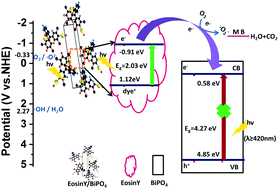Eosin Y sensitized BiPO4 nanorods for bi-functionally enhanced visible-light-driven photocatalysis†
Abstract
In this work, we report a novel photocatalyst of Eosin Y dye sensitized BiPO4 nanorods via a low-temperature and impregnation adsorption method. It shows enhanced visible-light-driven photocatalytic activity for degrading methylene blue (MB) and 2,4-DCP compared to that of pristine BiPO4 nanorods. The mass ratio of Eosin Y/BiPO4 is varied from 5 wt% to 30 wt% and the optimum value is 15 wt%, showing 46.7 and 10.5 fold greater apparent reaction rates than pristine BiPO4. Moreover, all of the reduced MB was transformed into CO2 and H2O during the photocatalysis, showing the good mineralization ability (almost 100%) of the composite. Furthermore, the photocatalytic mechanism of the composite is also investigated here by the zeta potential, scavenger experiments, Electron Paramagnetic Resonance (EPR), Photoluminescence Spectroscopy (PL), and a series of electrochemical analyses. The results show that (i) e− is the main reactive species and (ii) Eosin Y coated and adsorbed on BiPO4, thus widening the response range to the visible light region and accelerating the charge separation/transfer, resulting in bi-functionally promoted activity.



 Please wait while we load your content...
Please wait while we load your content...